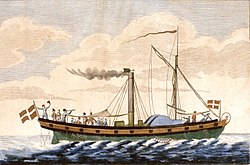Caledonia (ship, 1815)
|
Steamship Caledonia
|
||||||||||||
|
||||||||||||
|
||||||||||||
|
||||||||||||
|
||||||||||||
|
||||||||||||
The Caledonia was the second steamship to sail on the Rhine and the first to reach Koblenz . It was also the first steamship to fly the Danish flag.
history
The Caledonia was built in Glasgow in 1815 by James and Charles Wood and James Barclay. According to other sources, it was built by John Wood in Glasgow in 1814. The ship had a wooden hull and was powered by two 2-cylinder steam engines. Because the machines were ineffective, it was rarely used.
James Watt bought the ship from Henry Bell in April 1817 and had it equipped with two 2-cylinder steam engines with 14 hp each and a new boiler from Boulton & Watt , his own company. Watt tested the Caledonia at the Surrey Commercial Docks and reached a speed of about 8 knots with her . The ship was made seaworthy and the height of the paddle wheels was adjusted. After all optimizations had been implemented, the ship reached a speed of around 12 knots. In two races from the Surrey Commercial Docks to Gravesend , the Caledonia beat two other parcel ships - first the Thames and then the Sons of Commerce .
To test the strength of the machines, James Watt decided to sail the Rhine. The British naval officer William Wager, who had already transferred the Defiance to the Rhine two years earlier , brought the ship from Margate to Rotterdam in October 1817 , taking a day to the island of Walcheren . The journey from Rotterdam to Cologne took two days, with the ship struggling with strong headwinds and only one machine available for nine hours. It took three days from Königswinter to Koblenz, and the last stretch of the ship had to be towed by horses because of the strong current . On November 13, 1817, the Caledonia reached Koblenz and two days later she started her return journey. At Wesel , however, there was machine damage - the balancer was broken. Watt turned to Gottlob Jacobi in Sterkrade , who made a new steel balancer.
In 1819 the Caledonia was sold to Denmark . She was used as a package ship between Kiel and Copenhagen . The ship sailed from Copenhagen via Koster on Møn , Gåbense on Falster and Bandholm on Lolland and took about a day to get to Kiel. In 1819 the Caledonia drove the route 14 times and in 1820 22 times. In 1832, after 12 years, the ship was replaced by larger passenger steamers.
At the stern and on the bow cloths were each stretched under which the passengers could be assumed. Inside there was a lounge and a kitchen where people cooked with steam. There were also eight double rooms in which the passengers could sleep.
Web links
- THE FIRST STEAMBOAT SERVICES IN EUROPE at artistaswitness.com
- First steamship in Kripp
- PS Caledonia
literature
- Lohn Kennedy: The history of steam navigation , Liverpool 1903 ( archive.org )
- Wolfgang Klee, Detlev Luckmann: Steam Ships on the Rhine , 2010, ISBN 978-3-937189-51-2
Individual evidence
- ↑ Kiel Memorial Day: April 24, 1961 ( Memento of the original from September 11, 2016 in the Internet Archive ) Info: The archive link was inserted automatically and has not yet been checked. Please check the original and archive link according to the instructions and then remove this notice.
